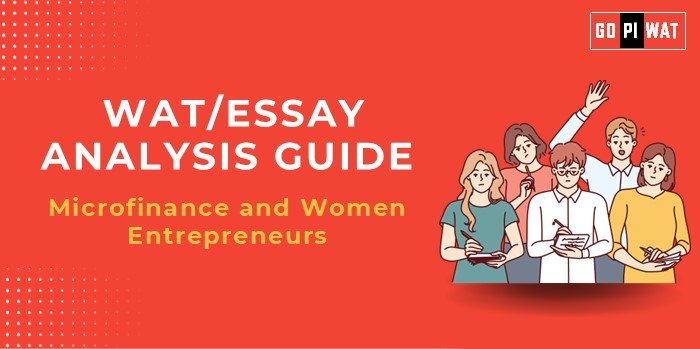📋 Written Ability Test (WAT) Analysis Guide
Topic: Microfinance and Women Entrepreneurs
🌐 Understanding the Importance of Microfinance
Microfinance intersects finance, gender studies, and development, making it a significant topic for essays. It exemplifies how financial tools can catalyze gender equity and economic growth.
📝 Effective Planning and Writing
- Time Allocation:
- Planning: 5 minutes
- Writing: 20 minutes
- Review: 5 minutes
- Essay Structure:
- Introduction: 60 words
- Body: 350 words
- Conclusion: 60 words
💡 Introduction Techniques
-
Contrast Approach:
“While women entrepreneurs drive economic growth, 1 in 3 women in developing countries lack access to formal credit. Microfinance bridges this gap.”
-
Solution-Based:
“Microfinance serves as a vital tool to empower women entrepreneurs by addressing financial exclusion, one of the biggest barriers to economic independence.”
📂 Structuring the Essay Body
- Achievements: Highlight case studies, e.g., Bangladesh’s Grameen Bank or Kenya’s M-Pesa.
- Challenges with Comparisons: Include barriers like cultural norms, contrasting with successful global models.
- Future Outlook: Discuss potential of digital platforms and integrated support systems.
📌 Concluding Effectively
- Balanced Approach: “Microfinance demonstrates its potential to empower women, but tackling cultural and operational barriers is essential.”
- Future-Focused: “As microfinance integrates with technology, its role in fostering gender equality will expand exponentially.”
🔑 Recommendations for Sustainable Progress
- Reduce interest rates through subsidies.
- Strengthen digital infrastructure for rural access.
- Promote financial literacy programs for women.
📄 Sample Short Essays
1. Balanced Perspective:
“Microfinance bridges the gap between financial exclusion and economic independence for women. While its success in empowering entrepreneurs is evident, addressing high interest rates and operational inefficiencies is crucial for equitable growth.”
2. Solution-Oriented:
“By integrating technology and offering lower-interest loans, microfinance institutions can scale their impact on women entrepreneurs, particularly in underserved rural areas.”
3. Global Comparison:
“From Grameen Bank in Bangladesh to mobile platforms like M-Pesa in Kenya, microfinance models have proven transformative. Lessons from these successes should inspire policy enhancements worldwide.”


